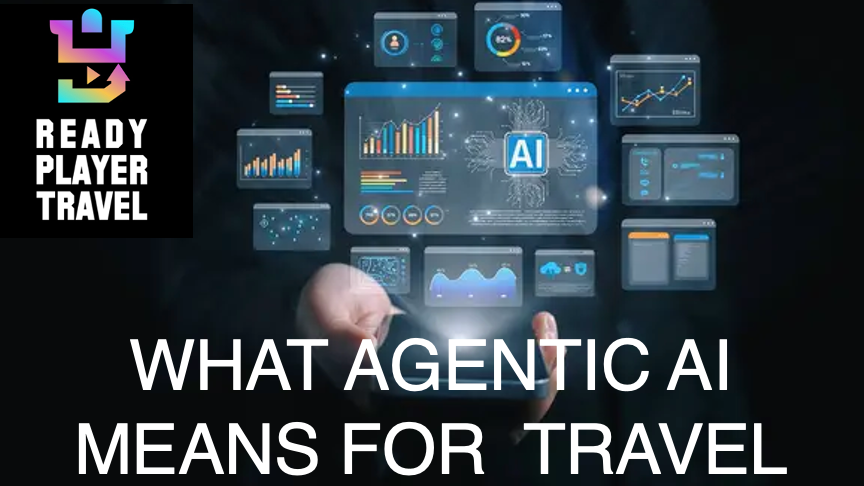BLOG
- August 4, 2025
What Agentic AI Means For Travel

Over the last year, “Agentic AI” has emerged as one of the buzziest concepts in tech. Everyone’s talking about autonomous agents. Everyone’s promising smarter personalization. But what does that actually look like for the travel industry?
For tourism brands, the answer might be simpler — and more powerful — than you think.
Because Agentic AI isn’t about replacing human marketers. It’s about deploying systems that actively help people plan, decide, and book — across every phase of their journey.
What Is Agentic AI?
Let’s break it down.
Unlike traditional GenAI tools that respond to individual prompts, Agentic AI refers to autonomous, goal-driven systems. These agents don’t wait for a user to ask. They’re designed to take initiative — to reason, plan, and act based on evolving goals and environmental context.
In simpler terms: it’s AI that doesn’t just answer questions — it helps get things done.
In travel, that means agents that don’t just provide recommendations — they:
- Help travelers refine their interests
- Handle tasks like bookings, itineraries, and updates
- Adapt to changes in real-time (like weather, closures, or cancellations)
- Provide personalized suggestions based on behavior, preferences, and context
What This Looks Like in Travel
The big shift? Instead of static recommendations or generic itineraries, travelers will get ongoing, contextual assistance from systems that feel more like a helpful friend or local expert — always one step ahead.
Let’s take a look at a few real-world examples:

HotelPlanner.com
AI Call Agents at Scale One of the UK’s largest hotel booking platforms launched 20 AI agents trained on 8 million call recordings. In just the first month, these agents:
- Handled 40,000 inquiries
- Generated £150,000 in booking revenue
- Are projected to help double total bookings in 2025
This is a clear use case for using AI to handle live inbound requests with efficiency and multilingual fluency.

Expedia’s AI Travel Assistant
Inside Expedia’s app lives a conversational travel assistant trained on rich hotel and destination data. It doesn’t just surface listings—it walks users through:
- Planning a trip based on personal interests
- Refining ideas over multiple prompts
- Retaining context (“romantic hotel near a vineyard”)
- Acting more like a human travel advisor than a static search bar
Expedia has confirmed its long-term vision: collapsing the inspiration-to-booking gap using agentic AI.

zIA: Italy’s “Auntie Concierge”
Created by Sapienza University with the Lazio region, zIA is a GenAI-powered local travel assistant trained to act like an Italian auntie:
- Warm, personable, culturally fluent
- Recommends local events, hidden gems, family-focused options
- Supports text, voice, and natural search queries
- Tailors advice pre-trip, mid-trip, and post-visit
It’s one of the most promising examples of persona-driven tourism agents, blending hospitality and local intelligence.

TUI: AI Concierge Pilot
TUI piloted an AI concierge across select resorts to:
- Help guests book activities
- Navigate amenities
- Change preferences mid-stay
The result? A 20% lift in guest satisfaction and increased in-destination revenue from tours and services.

GuideGeek: DMOs Get Conversational
Built by Matador Network and used by Discover Greece, Visit Reno Tahoe, Aruba Tourism, and others, GuideGeek delivers real-time recommendations via:
- Instagram DM
- Facebook Messenger
With over 98% accuracy through human-trained reinforcement learning, this white-labeled tool helps tourism boards offer highly responsive service across platforms travelers already use.

Agentic AI isn’t just a tool — it’s a new interface for how travelers plan and book.
Instead of pushing content into feeds and hoping for clicks, tourism brands will soon need to:
· Build agent-ready content (format, structure, context)
· Train agents on their destination or product data
· Offer value at the moment of discovery
For marketers, that means rethinking how discovery, personalization, and conversion happen. The opportunity to get ahead is now.
What This Means for Travel Marketers
- Agents Will Compete for Your Customers Soon, your biggest competitor might not be another brand. It could be an agent.
- Content Must Feed the Agents To stay visible, your content needs to be structured, tagged, and accessible to AI systems.
- Local Intelligence = Competitive Edge The more personalized your content (language, neighborhood, experience), the more AI agents will surface it.
- Early Adopters Will Win Just like the first brands to master SEO or social video, those who embrace agentic AI now will define the future playing field.
Where Travel Brands Can Take Action Today
Step 1: Build Your Agentic AI Strategy
Pilot an agent to power itinerary planning, travel advice, language localization, or OTA engagement. Use your existing GenAI content & OTA pipeline as the engine underneath it.
Step 2: Sync Agents with Video Funnels
Imagine an AI agent that not only plans, but triggers custom video creation (e.g. “48 Hours in [Destination]”), then uploads localized short-form edits to TikTok, Reels, and Booking platforms—all optimized for SEO and conversion.
Step 3: Collaborate with DMOs or Tech Partners
White-label solutions like GuideGeek or zIA-style agents can help regional destinations drive awareness while supporting local businesses—all integrated with booking and personalization.
Final Thought There was a time when the shift from desktop to mobile caught the industry off guard.
Agentic AI will be even bigger.
Brands that understand its implications early, and begin building for it now, will be tomorrow’s winners.

Destinate is the leading AI platform for the travel industry, helping brands scale operations, guest engagement, and marketing. From AI-powered trip planning to cinematic video production and intelligent automation, we deliver enterprise-grade tools built for tourism and hospitality innovators.
SUBSCRIBE
To Our Ready, Player, Travel Newsletter Today
LOCATIONS
- NORTH AMERICA Los Angeles, USA
- LATIN AMERICA Mazatlán, Mexico
- ASIA Hong Kong, SAR